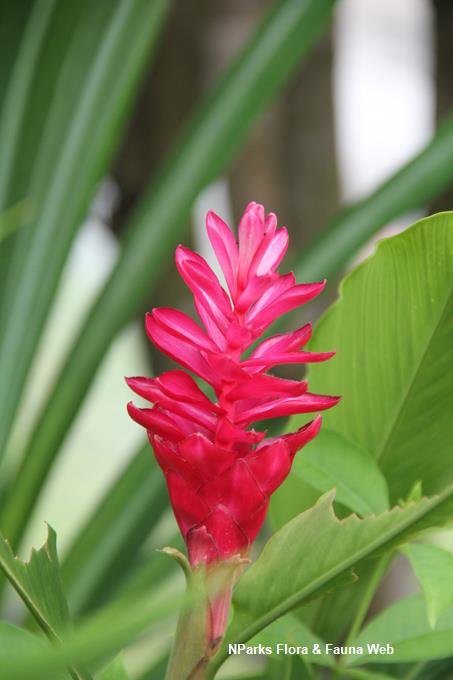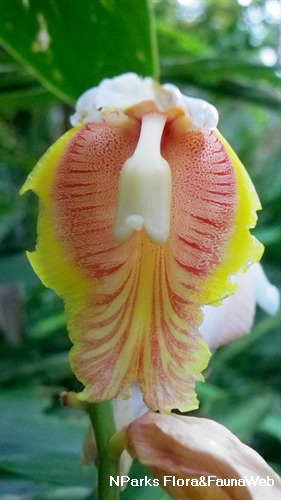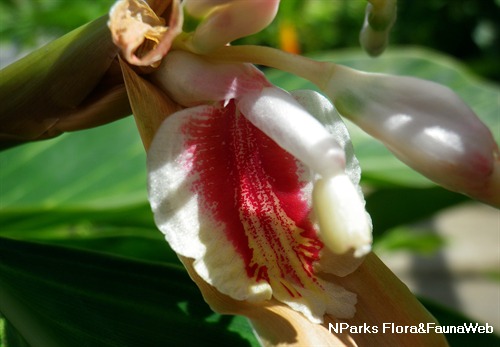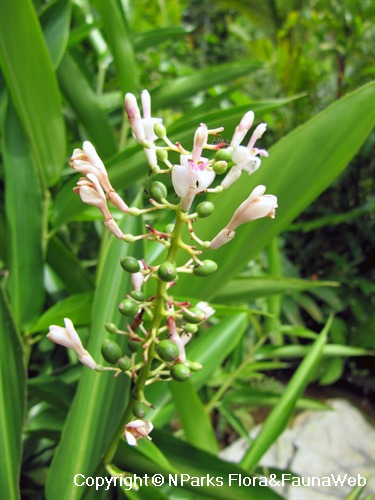.jpg)
Name
Classifications and Characteristics
| Plant Division | Angiosperms (Flowering Seed Plants) (Monocotyledon) |
|---|---|
| Plant Growth Form | Herbaceous Plant |
| Mode of Nutrition | Autotrophic |
Biogeography
| Native Distribution | South Pacific Islands |
|---|---|
| Native Habitat | Terrestrial |
| Preferred Climate Zone | Tropical, Sub-Tropical / Monsoonal |
| Local Conservation Status | Non-native (Horticultural / Cultivated Only) |
Description and Ethnobotany
| Growth Form | It is a herbaceous plants which grows upright up to 4 meters tall, and has leafy, cane-like stems. |
|---|---|
| Roots | Aromatic rhizomes, grow and spread in thick clusters, produce aerial shoots when older shoots dried up. |
| Foliage | Foliages sessile, alternate arrangement, long sheaths wrap around the stem; leaf blades oblong-shaped, measures 30 - 80 cm long and 10 - 20 cm wide; apex acute. |
| Flowers | A spike inflorescence, 15 - 30 cm long with bracts overlapping, forming cone or funnel shape; bracts ovate to broadly obovate, about 3 cm long; flowers tubular, white, about 0.5 cm, narrow lip. |
| Fruit | Rarely fruits, seed capsule, subglobose shaped, measures 10 - 15 cm long and 2 - 3 cm in diameter, splits open when ripe. Seeds measures about 0.2 cm long, black, oily. |
| Ethnobotanical Uses | Medicinal: The stems are used by Hawaiians for stomachaches. Salt and rhizomes are mashed together for treating headaches. Cut - Dried Flower: Bracts of red gingers are used for lei making. Others: The leaves produce subtle yellow dye. |
Landscaping Features
| Desirable Plant Features | Ornamental Flowers, Fragrant |
|---|---|
| Landscape Uses | Suitable for Roadsides, Parks & Gardens, Hedge / Screening |
| Thematic Landscaping | Fragrant / Aromatherapy Garden |
| Plant & Rootzone Preference or Tolerance Remarks | Wind and salt spray may cause browning, burned tip and discolouration. |
Plant Care and Propagation
| Light Preference | Semi-Shade, Full Sun |
|---|---|
| Water Preference | Occasional Misting, Lots of Water |
| Plant Growth Rate | Moderate |
| Rootzone Tolerance | Moist Soils, Well-Drained Soils, Fertile Loamy Soils |
| Planting Remarks | This plant can spread quite extensively, therefore use physical barriers (eg: plastic mow strip) surrounding the bed. |
| Transplanting Tolerance | Unknown / Unselect |
| Maintenance Requirements | Moderate |
| Pruning | Remove spent flowering shoots and yellowing foliage. |
| Propagation Method | Seed, Division, Aerial Plantlet |
| Propagation Method Remarks | Rhizome division |
Foliar
| Foliage Retention | Evergreen |
|---|---|
| Mature Foliage Colour(s) | Green |
| Foliar Type | Simple / Unifoliate |
| Foliar Arrangement Along Stem | Alternate |
| Foliar Attachment to Stem | Sessile |
| Foliar Shape(s) | Non-Palm Foliage (Oblong) |
| Foliar Margin | Entire |
| Foliar Apex - Tip | Acute |
| Leaf Area Index (LAI) for Green Plot Ratio | 3.5 (Shrub & Groundcover - Monocot) |
Non - Foliar and Storage
| Stem Type & Modification | Herbaceous |
|---|
Floral (Angiosperm)
| Flower Colour(s) | Red, White |
|---|---|
| Flower Grouping | Cluster / Inflorescence |
| Flower Location | Terminal |
| Individual Flower Shape | Tubular |
| Inflorescence Type | Spike |
Fruit, Seed and Spore
| Fruit Type | Dehiscent Dry Fruit , Capsule |
| Mature Seed Colour(s) | Black |
|---|
| Mature Seed Texture(s) | Waxy |
Image Repository
Others
| Master ID | 349 |
|---|---|
| Species ID | 1645 |
| Flora Disclaimer | The information in this website has been compiled from reliable sources, such as reference works on medicinal plants. It is not a substitute for medical advice or treatment and NParks does not purport to provide any medical advice. Readers should always consult his/her physician before using or consuming a plant for medicinal purposes. |


-(1).jpg)
.jpg)
.jpg)






